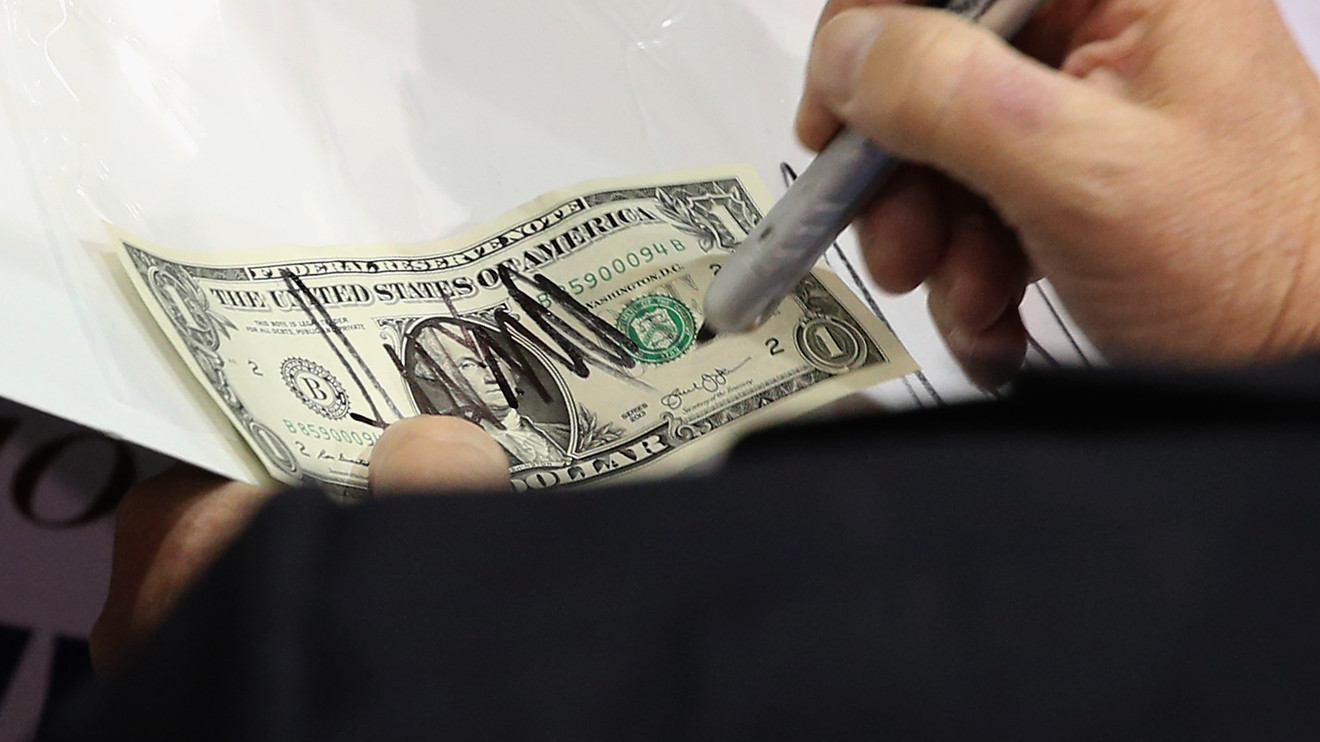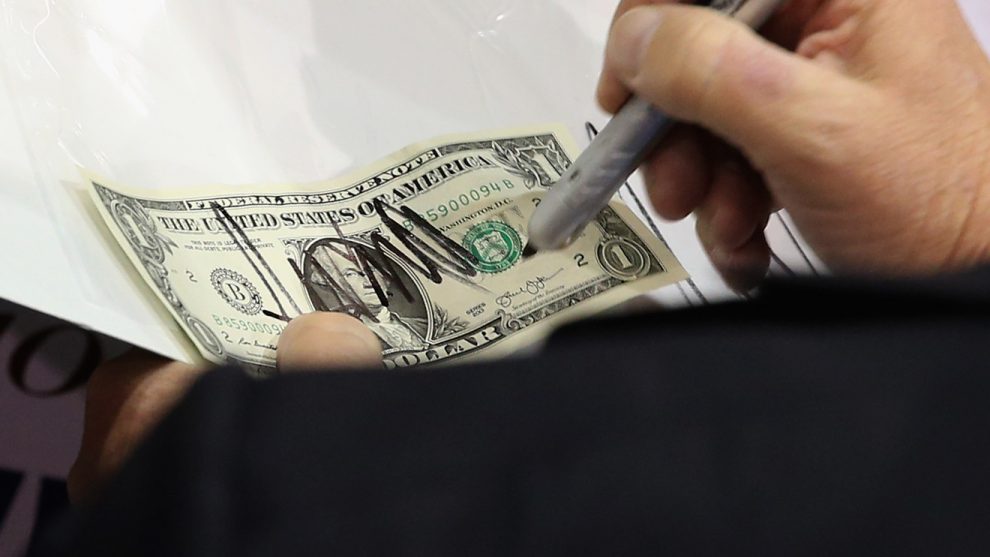
President Donald Trump seems to be doing all he can to talk down the value of the U.S. dollar, and traders see a rising risk that the administration could do something more concrete.
“Trade wars and intervention fears continue to dominate the FX outlook…The global race to the bottom is likely to keep the pressure on the Fed to continue to cut rates and though our base case remains that FX intervention is unlikely, we think that the risks have risen,” wrote currency analysts at Bank of America Merrill Lynch, in a Friday note.
Read: Why the ‘tail risk of a currency war can’t be ruled out’ as U.S.-China tensions mount
So far, Trump has put the onus on the Federal Reserve. Asked Friday about the prospect of devaluing the dollar, Trump said, “No, we don’t have to,” adding that a Fed rate cut “would automatically bring down the dollar a little bit,” according to news reports.
But the threat of the U.S. government wading into the currency market by itself to sell dollars in an effort to weaken the currency — a nearly unthinkable concept in recent decades — is one that investors haven’t been able to shake despite an assurance last month by White House economic adviser Larry Kudlow that direct intervention was off the table. And it wasn’t clear that Trump’s remark Friday, in response to a question, would put the issue to rest, either.
Check out: Currency intervention: Here’s how the U.S. could move to weaken the dollar
A steady stream of angry tweets over the value of the dollar have kept the threat alive, contributing to the growing fear of a global currency war — a string of competitive devaluations that devolve into a proverbial “race to the bottom,” potentially undermining financial stability and the world economy.
Indeed, those worries were underlined Thursday when Trump took to Twitter to reiterate his unhappiness with the strength of the dollar, again blaming the Fed for keeping its value high and making life more difficult for U.S. manufacturers like Caterpillar Inc. CAT, -2.13% and Boeing Co. BA, +0.54%.
The ICE U.S. Dollar Index DXY, -0.12%, a measure of the U.S. currency against a basket of six major rivals, is down 0.6% this week. That reflects, in part a 1.1% fall versus the Japanese USDJPY, -0.46%, a traditional safe haven asset, which was boosted by financial market volatility earlier this week after China allowed its currency to fall.
Wall Street was set to end a volatile week on a down note after beginning it Monday with the worst day for equities so far this year. The Dow Jones Industrial Average DJIA, -0.13% is on track for a 1.4% weekly fall, while the S&P 500 SPX, -0.48% is down 0.9%.
The U.S. Treasury Department earlier this week formally designated China a currency manipulator after Beijing, paradoxically, failed to prevent the yuan from weakening above the 7-per -dollar level.
See: Why a falling Chinese yuan crushed the stock market and intensified the trade war
Chris Turner, global head of strategy at ING, took a look at the FX options market in a rough attempt Friday to gauge where traders now see the odds of U.S. intervention.
Assuming that unilateral U.S. intervention would knock the dollar down by 3%, he took a look at one-touch options, which pay a premium to the holder if the spot rate hits the strike price any time before the option expires, for the U.S. dollar/Japanese yen currency pair, euro/U.S. dollar EURUSD, +0.2415% and U.S. dollar/Chinese yuan USDCNY, +0.2441%. Those options prices reflect a 23%, 13%, and 9% chance, respectively, of a 3% move over the next month, he said, in a Friday note.
That’s a rough guide, Turner said, noting that since the dollar/yen is more volatile than euro/U.S. dollar or dollar/yuan, the probability of a big move versus the Japanese currency is naturally higher.
In the note, written before Trump’s Friday comments, Turner said ING put the probability of intervention at 25%. Asked if Trump’s comments playing down the prospect of devaluation changed the odds, Turner, by email, said it might make the chances “slightly lower, but not much.”
Trump’s comments probably take into account the view that unilateral intervention is unlikely to work, Turner said, which was a big part of the reason ING saw only a 1-in-4 chance of action.
“How would the White House react to headlines of ‘failed intervention’ if after selling USD/CNY at 7.05, the spot rate trades above that level over later days and weeks as the Fed fails to reappear with a sustained bout of USD/CNY selling,” Turner said, in the note.
Those concerns speak to the debate over how much firepower the U.S. could bring to bear were it to attempt intervention on its own. While the Treasury Department would make the call, the intervention itself would be carried out by the Fed. The Treasury Department has around $94 billion it could use in an attempt to move the dollar, according to Bloomberg, a relatively small amount in a global currency market with more than $5 trillion in daily turnover.
For the intervention to be effective, the Fed would likely need to add its own support to the effort — something that’s seen as far from guaranteed. And to be truly effective, Congress would need to approve a massive increase in Treasury resources for intervention, which would raise debt levels, Turner said. Another alternative is for the Fed to decide to print dollars and support the Treasury in unsterilized interventions. Sterilization refers to the process of draining the dollars created by the Fed’s intervention from the financial system through selling debt keep interest rates steady.
There’s also been increased talk of revisiting the Plaza Accord, a 1985 agreement struck by the U.S. and other global economic powers to weaken the dollar and address the domestic and international imbalances associated with Reagan-era U.S. policies. But Turner, like many observers, sees little appetite for a new accord.
Check out: Why a 1985 global deal to weaken the dollar offers a road map to ending the trade war
Instead, a significant game-changer could come from the Fed if it were to signal it was giving more weight to the drag from the international environment, including the strong dollar.
“The Fed might not wish to risk its credibility in getting sucked into a currency war,” he said, “but FX intervention backed up by more aggressive Fed easing would be a more compelling proposition for the FX market.”











Add Comment